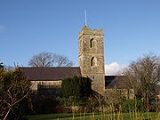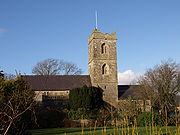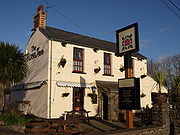
Redwick, Newport
Encyclopedia
Redwick is a small village
and community parish
to the south east of the city
of Newport
, in South Wales
, United Kingdom
. It lies within the Newport city boundaries, in the historic county of Monmouthshire
and the preserved county of Gwent
.
on the flat coastal lands reclaimed from the Severn Estuary
and Bristol Channel
and part of the Caldicot and Wentloog Levels
.
 The ancient church of St. Thomas the Apostle
The ancient church of St. Thomas the Apostle
is notable for many unusual features. An earlier dedication, when it belonged to Tintern Abbey
, appears to have been St. Michael. It is held with Magor
.
The church is unusually large for a parish church on the Caldicot and Wentloog Levels
, perhaps second only in its grandeur to that at Peterstone
. The church has a full-immersion baptisty, unique medieval stone carvings and a fine Victorian
pipe organ
salvaged from two previous churches. On the ancient south porch is a distinctive 'scratch post' or "Mass sundial" and (like the church at nearby Goldcliff) has a mark indicating the flood level of the water inundation caused by the Bristol Channel flood, 1607. The handsome font
originates from the 13th century and may have been an original feature.
Its embattled and pinnacled central tower contain six bells, the fourth and fifth of which are pre-reformation bells from the Bristol
foundry, dated circa circa 1350-80 making them some of the oldest church bells working anywhere in the country. Most unusually, following their lowering in the tower in the 1990s, the bells are rung from the chancel
in full view of the congregation, although a number of old unused rope bosses suggest that this must have also been the case at some time in the past. The newest bell is the treble (lightest bell) which was added in celebration of HM Queen Elizabeth II's 40 years on the throne.
The fine East window, which contains some painted glass from about 1870, unlike the roof and the other windows, escaped the near-by German Luftwaffe
bomb blast of 1942. The restoration and re-modelling on the church, including the attractive raised tiled floor, in 1875, was by John Norton
who later also participated in the building of the exquisite chapel at Tyntesfield
in Somerset
.
 The village pub is the Rose Inn.
The village pub is the Rose Inn.
façade was built around 1795, by MP
William Phillips. Phillips, built the Brick House ready for his son's return to Britain from the American Colonies. The son, also named William, never returned, however, as the ship carrying him home was wrecked in a storm before reaching Britain and he was drowned. The house is now a guest house.
timber buildings on the foreshore at Redwick have been examined by Smith and colleagues. Four rectangular buildings of middle Bronze Age date
have also been excavated on intertidal peat at Redwick - such buildings
appear to have been used during seasonal pastoral activity on the wetland. Martin Bell and colleagues from the University of Reading
have studied Mesolithic
to Neolithic
coastal environmental change
at Redwick.
and the Redwick, Newport community council
.
Village
A village is a clustered human settlement or community, larger than a hamlet with the population ranging from a few hundred to a few thousand , Though often located in rural areas, the term urban village is also applied to certain urban neighbourhoods, such as the West Village in Manhattan, New...
and community parish
Parish
A parish is a territorial unit historically under the pastoral care and clerical jurisdiction of one parish priest, who might be assisted in his pastoral duties by a curate or curates - also priests but not the parish priest - from a more or less central parish church with its associated organization...
to the south east of the city
City
A city is a relatively large and permanent settlement. Although there is no agreement on how a city is distinguished from a town within general English language meanings, many cities have a particular administrative, legal, or historical status based on local law.For example, in the U.S...
of Newport
Newport
Newport is a city and unitary authority area in Wales. Standing on the banks of the River Usk, it is located about east of Cardiff and is the largest urban area within the historic county boundaries of Monmouthshire and the preserved county of Gwent...
, in South Wales
South Wales
South Wales is an area of Wales bordered by England and the Bristol Channel to the east and south, and Mid Wales and West Wales to the north and west. The most densely populated region in the south-west of the United Kingdom, it is home to around 2.1 million people and includes the capital city of...
, United Kingdom
United Kingdom
The United Kingdom of Great Britain and Northern IrelandIn the United Kingdom and Dependencies, other languages have been officially recognised as legitimate autochthonous languages under the European Charter for Regional or Minority Languages...
. It lies within the Newport city boundaries, in the historic county of Monmouthshire
Monmouthshire (historic)
Monmouthshire , also known as the County of Monmouth , is one of thirteen ancient counties of Wales and a former administrative county....
and the preserved county of Gwent
Gwent (county)
Gwent is a preserved county and a former local government county in south-east Wales. It was formed on 1 April 1974, under the Local Government Act 1972, and was named after the ancient Kingdom of Gwent....
.
Location
Redwick is located six miles south east of the city of Newport and some four miles south west of Caldicot, MonmouthshireCaldicot, Monmouthshire
Caldicot is a small town in Monmouthshire, southeast Wales, located between Chepstow and Newport, just off the busy M4 / M48 motorway corridor. The site adjoins the Caldicot Levels, on the north side of the Severn estuary. Caldicot has easy access by motorway and rail to Cardiff, and across the...
on the flat coastal lands reclaimed from the Severn Estuary
Severn Estuary
The Severn Estuary is the estuary of the River Severn, the longest river in Great Britain. Its high tidal range means it has been at the centre of discussions in the UK regarding renewable energy.-Geography:...
and Bristol Channel
Bristol Channel
The Bristol Channel is a major inlet in the island of Great Britain, separating South Wales from Devon and Somerset in South West England. It extends from the lower estuary of the River Severn to the North Atlantic Ocean...
and part of the Caldicot and Wentloog Levels
Caldicot and Wentloog Levels
The Caldicot and Wentloog Levels are two areas of low-lying estuarine alluvial wetland and intertidal mudflats adjoining the north bank of the Severn estuary, either side of the River Usk estuary near Newport in south east Wales...
.
The Church

St. Thomas the Apostle
Saint Thomas the Apostle was one of the twelve disciples of Jesus.It may also refer to:-Places:*St. Thomas the Apostle , a large civil parish in Devon, England*St Thomas the Apostle Rural, a civil parish in east Cornwall, United Kingdom-Other:...
is notable for many unusual features. An earlier dedication, when it belonged to Tintern Abbey
Tintern Abbey
Tintern Abbey was founded by Walter de Clare, Lord of Chepstow, on 9 May 1131. It is situated in the village of Tintern, on the Welsh bank of the River Wye in Monmouthshire, which forms the border between Monmouthshire in Wales and Gloucestershire in England. It was only the second Cistercian...
, appears to have been St. Michael. It is held with Magor
Magor
Magor may refer to the following:* Ivan Martin Jirous – a Czech underground poet* Magor , a character from J. R. R. Tolkien's legendarium of Middle-earth* Magor is a legendary ancestor of the Hungarian people, see Hunor and Magor...
.
The church is unusually large for a parish church on the Caldicot and Wentloog Levels
Caldicot and Wentloog Levels
The Caldicot and Wentloog Levels are two areas of low-lying estuarine alluvial wetland and intertidal mudflats adjoining the north bank of the Severn estuary, either side of the River Usk estuary near Newport in south east Wales...
, perhaps second only in its grandeur to that at Peterstone
Peterstone
Peterstone or Peterstone Wentlooge is a small hamlet on the to the south west of the city of Newport, South Wales.- Location :Peterstone Wentlooge lies six miles to the west of Newport, close to the eastern edge of Cardiff....
. The church has a full-immersion baptisty, unique medieval stone carvings and a fine Victorian
Victorian era
The Victorian era of British history was the period of Queen Victoria's reign from 20 June 1837 until her death on 22 January 1901. It was a long period of peace, prosperity, refined sensibilities and national self-confidence...
pipe organ
Pipe organ
The pipe organ is a musical instrument that produces sound by driving pressurized air through pipes selected via a keyboard. Because each organ pipe produces a single pitch, the pipes are provided in sets called ranks, each of which has a common timbre and volume throughout the keyboard compass...
salvaged from two previous churches. On the ancient south porch is a distinctive 'scratch post' or "Mass sundial" and (like the church at nearby Goldcliff) has a mark indicating the flood level of the water inundation caused by the Bristol Channel flood, 1607. The handsome font
Baptismal font
A baptismal font is an article of church furniture or a fixture used for the baptism of children and adults.-Aspersion and affusion fonts:...
originates from the 13th century and may have been an original feature.
Its embattled and pinnacled central tower contain six bells, the fourth and fifth of which are pre-reformation bells from the Bristol
Bristol
Bristol is a city, unitary authority area and ceremonial county in South West England, with an estimated population of 433,100 for the unitary authority in 2009, and a surrounding Larger Urban Zone with an estimated 1,070,000 residents in 2007...
foundry, dated circa circa 1350-80 making them some of the oldest church bells working anywhere in the country. Most unusually, following their lowering in the tower in the 1990s, the bells are rung from the chancel
Chancel
In church architecture, the chancel is the space around the altar in the sanctuary at the liturgical east end of a traditional Christian church building...
in full view of the congregation, although a number of old unused rope bosses suggest that this must have also been the case at some time in the past. The newest bell is the treble (lightest bell) which was added in celebration of HM Queen Elizabeth II's 40 years on the throne.
The fine East window, which contains some painted glass from about 1870, unlike the roof and the other windows, escaped the near-by German Luftwaffe
Luftwaffe
Luftwaffe is a generic German term for an air force. It is also the official name for two of the four historic German air forces, the Wehrmacht air arm founded in 1935 and disbanded in 1946; and the current Bundeswehr air arm founded in 1956....
bomb blast of 1942. The restoration and re-modelling on the church, including the attractive raised tiled floor, in 1875, was by John Norton
John Norton
John Norton may refer to:*John Norton, 5th Baron Grantley , British peer and numismatist*John Norton , Victorian Gothic revivalist, remodelled Tyntesfield*John Norton , Olympic medalist...
who later also participated in the building of the exquisite chapel at Tyntesfield
Tyntesfield
Tyntesfield is a Victorian Gothic Revival estate near Wraxall, North Somerset, England, near Nailsea, seven miles from Bristol.The house was acquired by the National Trust in June 2002 after a fund raising campaign to prevent it being sold to private interests and ensure it be opened to the public...
in Somerset
Somerset
The ceremonial and non-metropolitan county of Somerset in South West England borders Bristol and Gloucestershire to the north, Wiltshire to the east, Dorset to the south-east, and Devon to the south-west. It is partly bounded to the north and west by the Bristol Channel and the estuary of the...
.
Notable features

Whithall Farm/Redbrick House
The earliest Church records show that there has been a house, then called Whitehall Farm, on the site since 1450. The main GeorgianGeorgian architecture
Georgian architecture is the name given in most English-speaking countries to the set of architectural styles current between 1720 and 1840. It is eponymous for the first four British monarchs of the House of Hanover—George I of Great Britain, George II of Great Britain, George III of the United...
façade was built around 1795, by MP
Member of Parliament
A Member of Parliament is a representative of the voters to a :parliament. In many countries with bicameral parliaments, the term applies specifically to members of the lower house, as upper houses often have a different title, such as senate, and thus also have different titles for its members,...
William Phillips. Phillips, built the Brick House ready for his son's return to Britain from the American Colonies. The son, also named William, never returned, however, as the ship carrying him home was wrecked in a storm before reaching Britain and he was drowned. The house is now a guest house.
Archaeology
Insects from samples of Bronze AgeBronze Age
The Bronze Age is a period characterized by the use of copper and its alloy bronze as the chief hard materials in the manufacture of some implements and weapons. Chronologically, it stands between the Stone Age and Iron Age...
timber buildings on the foreshore at Redwick have been examined by Smith and colleagues. Four rectangular buildings of middle Bronze Age date
have also been excavated on intertidal peat at Redwick - such buildings
appear to have been used during seasonal pastoral activity on the wetland. Martin Bell and colleagues from the University of Reading
University of Reading
The University of Reading is a university in the English town of Reading, Berkshire. The University was established in 1892 as University College, Reading and received its Royal Charter in 1926. It is based on several campuses in, and around, the town of Reading.The University has a long tradition...
have studied Mesolithic
Mesolithic
The Mesolithic is an archaeological concept used to refer to certain groups of archaeological cultures defined as falling between the Paleolithic and the Neolithic....
to Neolithic
Neolithic
The Neolithic Age, Era, or Period, or New Stone Age, was a period in the development of human technology, beginning about 9500 BC in some parts of the Middle East, and later in other parts of the world. It is traditionally considered as the last part of the Stone Age...
coastal environmental change
Environmental change
Environmental change is defined as a change or disturbance of the environment by natural ecological processes, and is described in the following articles:*Climate change*Environment...
at Redwick.
History
The church registers, which date from 1787, contain an unpleasant reminder of legal processes of not so very long ago. The last man to be hanged for sheep stealing in Monmouthshire was charged before local magistrates assembled at The Great House in the village.Government
The area is governed by the Newport City CouncilNewport City Council
Newport City Council is the governing body for the city of Newport, one of the subdivisions of Wales within the United Kingdom. It consists of 50 councillors, representing the city's 20 wards. Since the 2008 election, the council has been controlled jointly by the Conservatives and Liberal...
and the Redwick, Newport community council
Community council
A community council is a public representative body in Great Britain.In England they may be statutory parish councils by another name, under the Local Government and Public Involvement in Health Act 2007, or they may be non-statutory bodies...
.

